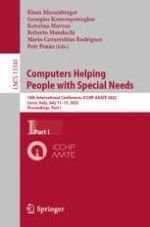1 Introduction
2 Methodology
2.1 Online Survey
2.2 Study Participants
3 Results
3.1 Subjective Technology Adaptivity
3.2 Use Intention for Emerging Technologies
Physical (n = 297) | Visual (n = 85) | Hearing (n = 45) | Ment. Health issues (n = 16) | Intellectual (n = 17) | Multiple (n = 85) | |
|---|---|---|---|---|---|---|
Navigation systems | r = .15 f = .15 (.009) | r = .32 f = .34 (.003) | r = .29 f = .30 (.058) | r = .28 f = .29 (.300) | r = .31 f = .33 (.222) | r = .16 f = .16 (.141) |
AI-based alerts | r = .14 f = .14 (.019) | r = .34 f = .36 (.002) | r = .34 f = .36 (.023) | r = .38 f = .41 (.143) | r = .55 f = .66 (.021) | r = .14 f = .14 (.192) |
Wearables | r = .14 f = .14 (.013) | r = .25 f = .26 (.021) | r = .17 f = .17 (.254) | r = .13 f = .13 (.624) | r = .36 f = .39 (.155) | r = .29 f = .30 (.007) |
Robots | r = .25 f = .26 (.001) | r = .20 f = .20 (.065) | r = .32 f = .34 (.032) | r = .16 f = .16 (.561) | r = .27 f = .28 (.032) | r = .22 f = .23 (.049) |
Augmented reality | r = .17 f = .17 (.003) | r = .26 f = .27 (.015) | r = .13 f = .13 (.393) | r = .01 f = .01 (.998) | r = .48 f = .55 (.049) | r = .19 f = .19 (.078) |
Location-based alerts | r = .21 f = .21 (.001) | r = .14 f = .14 (.193) | r = .30 f = .31 (.043) | r = .12 f = .12 (.667) | r = .61 f = .77 (.009) | r = .09 f = .09 (.405) |
